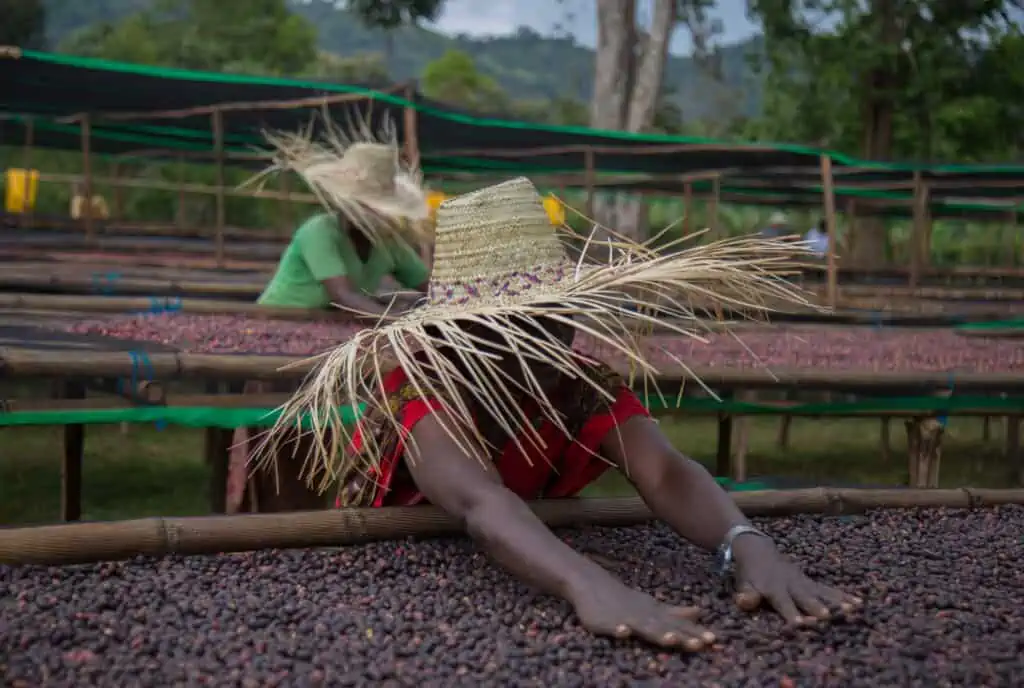
Spreading coffee fruit for drying in Ethiopia. Courtesy of Royal Coffee NY.
While there is much to be said for the new and different in coffee — for surprising new cup profiles generated by the latest processing methods, tiny lots of coffee produced from newly rediscovered tree varieties — there is also a lot to be said for the pleasures of consistency. Even for those coffee lovers willing to pay big bucks for a few extraordinary cups of a super-distinctive Geisha fermented in sealed tanks with special yeasts, the morning may come when they may want a cup that pleases less with surprise and more with everyday satisfaction. Something special, but perhaps not $80-per-four-ounces special. The same reasonably priced special cup they enjoyed last week, say, or two weeks ago, or even last month.
And although predictable satisfaction can be gotten from blends, a blend can be, at the other extreme, a bit too predictable. So, what fills in the gap between pricey, fleetingly available microlots and everyday blends?
A Sumatra Drinker for Life
Everyday single-origin coffees, of course, the subject of this report. Coffees from a single country, usually from a single region or farm/cooperative, bought by the roaster in sufficient quantity to sell for some time, for months or longer. Usually, roasters do their best maintain continuity from year to year by buying from the same farm or exporter. They also try to buy beans that are well-conditioned and stand up to storage.
Such single-origin coffees with their familiar market names – Colombia Supremo, Guatemala Antigua, Kenya AA – were once the mainstay of specialty coffee. In a sense these origin names are brands that specialty roasters tap into free of charge. Their customers often have their favorites. I had a close friend who drank nothing but Sumatra Mandheling bought from Peet’s Coffee for almost her entire life. If she went someplace that wasn’t Peet’s she would still look for a Sumatra Mandheling.
When we put out a call for today’s versions of such staple single-origin coffees, coffees that have been purchased by the roaster in enough volume to roast and offer over the course of months, we received nearly 60 coffees from about 40 different roasting companies in North America and Taiwan.
A Quiet Individuality
We did get one Sumatra, a rather nice coffee, with enough earth and tobacco to please my friend, but not enough for us to overlook its rather downbeat structure. But what else did we get?
In fact, an impressive range of what we asked for. True, many of the everyday single-origins we received were a little too familiar, simply too everyday, as it were. Maybe good enough to get us satisfyingly awake and out the door but not distinctive enough to give us a little goose of pleasure or surprise, to persuade us to pay attention to what we’re drinking.
But the best of these 60 samples proposed a quiet individuality, a place where the familiar and surprising intersect. We review 10 of these exceptional everyday coffees here.
Everyday Coffees and Processing Method
Most of the samples we received were processed by the conventional wet or washed method, the standard processing method for mainstream quality coffee. A substantial minority, however, (12 of 60) were processed by the ancient, but increasingly trendy, dried-in-the-fruit or natural method. But we received almost no samples processed by latest alternative or experimental methods. For example, we received only one sample processed using a variation of the fashionable anaerobic (limited oxygen ferment) method and only two by the honey method.
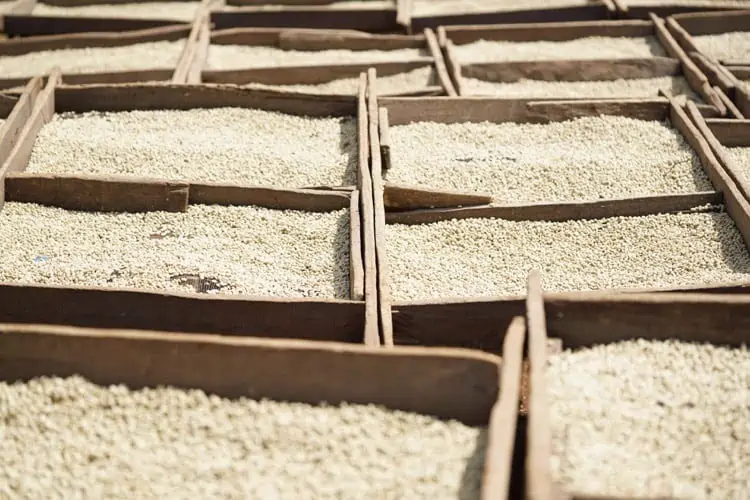
Washed-process coffees drying in trays, Ethiopia. Courtesy of importer Pebble Coffee, Taiwan.
The predominance of washed coffees is not because the wet method is cheaper for producers than, say, the natural method. What it reflects is the fact that washed or wet-processed coffees are generally more reliable and predictable than coffees processed by other methods, particularly when produced in larger quantities. Recall that in the washed method the fruit flesh is removed before the beans are dried, reducing the risk of various off-tastes developing from contact between bean and fruit residue during drying. (While also, of course, reducing the opportunity to customize such drying in an effort to achieve the fruit-forward notes enjoyed by many contemporary coffee drinkers). Also, because washed coffees are used in large quantities in premium or quality blending throughout the world, they are more dependably available for smaller specialty roasters looking for everyday single-origin coffees of the kind we report on this month.
Of course, it is also probably true that some consumers who gravitate to these everyday single-origins may particularly welcome the consistency and familiarity of washed profiles. Ian Picco, Director of Coffee at Topeca Coffee, reports that “we cater to two distinct segments of coffee consumers: those who value variety and like to try new origins and coffee profiles, and those who appreciate the comfort and predictability of their one favorite blend or single origin bean. The latter group far outweighs the former, so it’s important to cater to this crowd in addition to keeping things fresh with seasonal offerings.” Several roasters who corresponded with me on this month’s topic made a similar point.
A Range of Washed Coffees
Nevertheless, coffees processed by the washed method are hardly taste-alike clones. The tree varieties that produce the coffee vary, the details of the wet processing vary, the weather varies, terroirs vary.
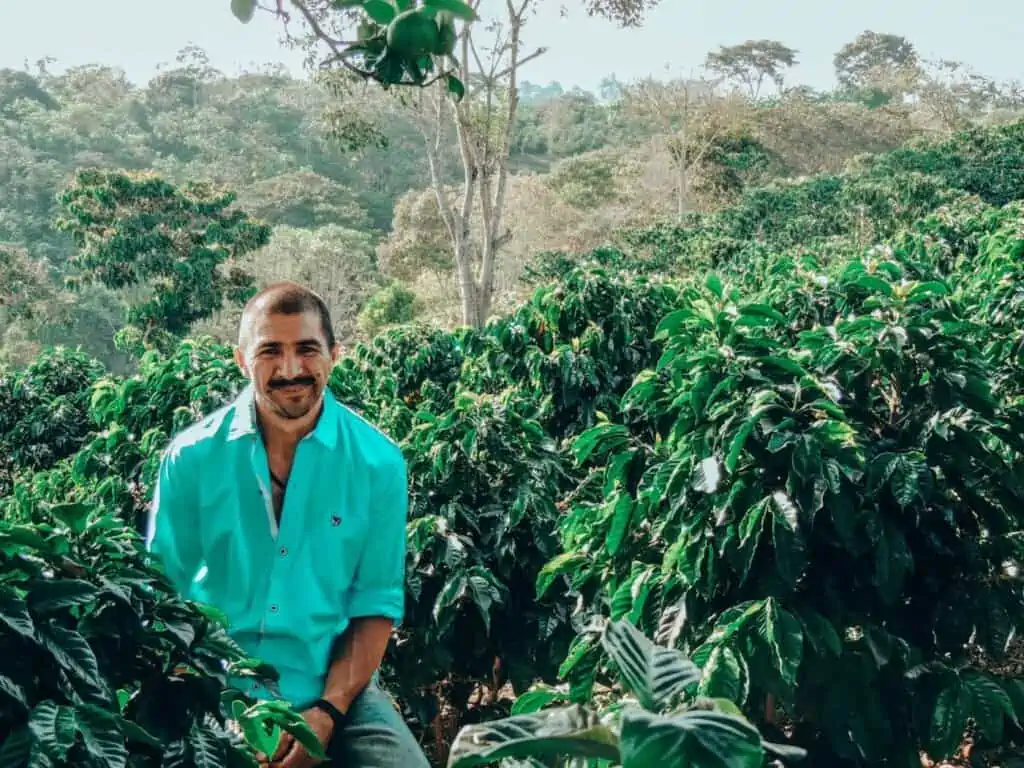
Producer from the Laboyano Group of growers, Colombia. Courtesy of importer The Coffee Quest.
One thing is certain: The eight washed coffees we review this month embody an exciting and engaging range of the type. At the pure, bright, straightforward end of the washed spectrum, I would place the Topeca Colombia Laboyano (92), a fine classic coffee in the high-grown Colombia mode: clean, direct, with a bright but smooth acidity and simple but satisfying apricot/stone fruit nuance. The Speedwell El Salvador Monte Verde (92) is similarly pure in profile but considerably softer in expression (most likely owing to lower growing elevations), with gently expressed acidity, deep sweetness, and cocoa, flowers and nut. Remarkably, given the traumas El Salvador has endured over recent decades, it is roughly the same elegantly gentle style of washed El Salvador I admired over 40 years ago when I wrote my first book on coffee. Derek Anderson, owner of Speedwell, says his company focuses particularly on El Salvador, Guatemala and Colombia when looking for larger lots of coffee for long-term offerings, concluding, “We really do embrace the challenge to find and roast these great single-origin coffees that do not break the bank, nor disappear in a month.”
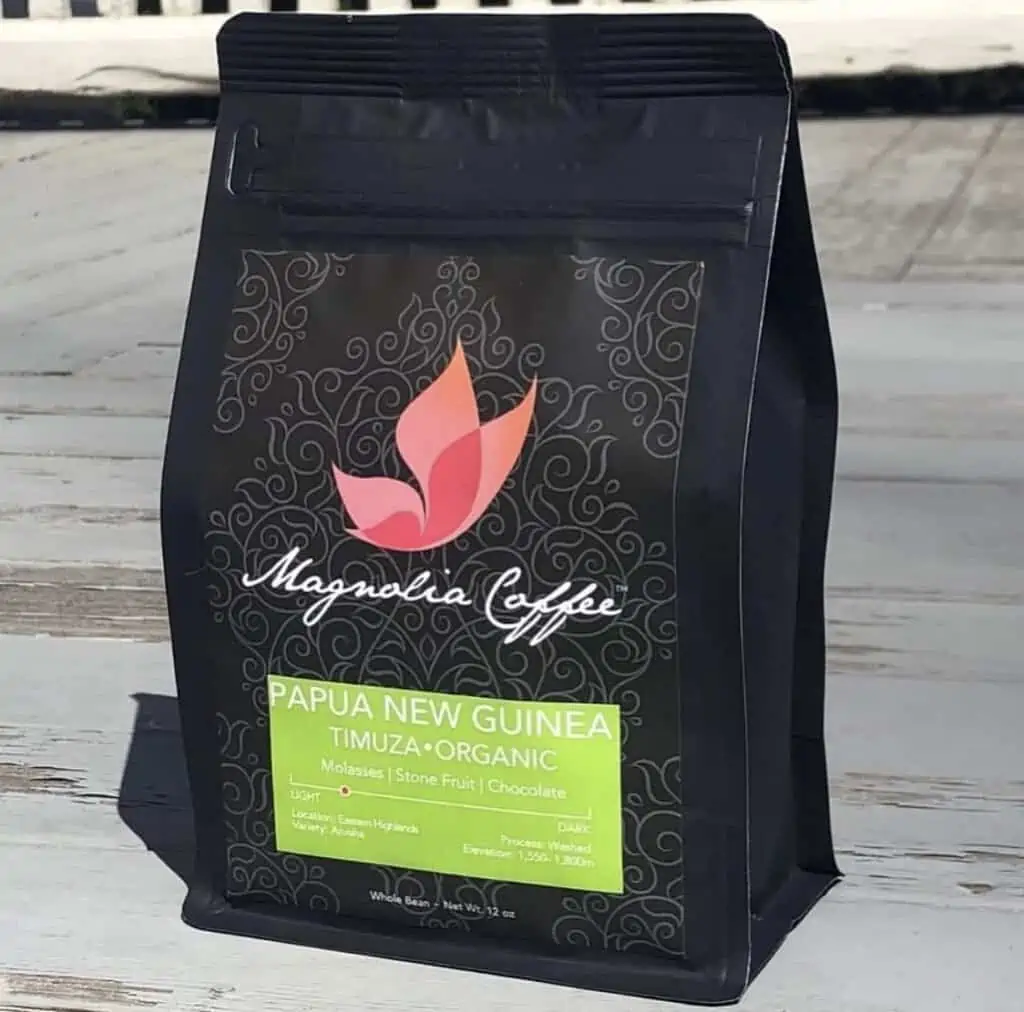
Magnolia Coffee’s 92-point Papua New Guinea Timuza Organic. Courtesy of Magnolia Coffee.
The Magnolia Timuza (92) organic from the often-overlooked origin Papua New Guinea (92) is another sweetly bright classic, here with a crisp edge to the acidity and orangy and almondy aromatics. Jay Gestwicki, Founder and Director of Coffee at Magnolia, reports, “Coffees from Papua New Guinea have become a big part of our program. They are still quite rare in the scope of coffee, and they introduce people to unique tastes without being so different that they can turn people away from thinking they don’t like specialty coffee. Our Papua New Guinea Timuza is a great example — it’s an easy-drinking washed coffee, yet it has enough complexity and nuance for anyone to notice it’s special.”
Enter the Ethiopias
Of the 10 coffees we review this month, six were produced in Ethiopia. And based on ratings, we could have reviewed at least two more Ethiopias. We held off because we did not want too much focus on only one origin, however admirable its production.
Why so many Ethiopias? Almost certainly because Ethiopian tree varieties are unique in the world with respect to the distinctive character of their aromatic profiles. Recall that Geisha/Gesha is an Ethiopian variety. And these distinctive Ethiopia coffees tend to be plentiful and reasonable in price.
Of the six Ethiopias we did review, five are washed process, though, again, the washed profiles vary. Two, the St1 Cafe Ethiopia Guji Raro (93) and the MK Coffee Roasters Sidamo Washed (93), display the sweet brightness of classic washed coffees but tempered by the gentleness and fragrant complexity particularly associated with Ethiopia. I found that I used the words “suave” and “balanced” when reviewing both of these coffees, and for both cited a similar vanilla-like slant to their layered floral character. Carrie Chang of St1 Café reported that the Guji Raro was her “June and July sales champion” because many of her customers “like the soft, gently and sweet floral notes.”
Three more washed Ethiopias displayed variations on another characteristic tendency of the southern washed Ethiopia type: soft and gentle, but also crisp, brisk, often spicy. These variations in profile could be owing to exposure to moisture during drying (it tends to drizzle in many of the famous southern Ethiopia regions during harvest), but there doubtless are other reasons as well. With the Cup to Cup Ethiopia Yirgacheffe Kochere (93), the crisp, spicy, savory-edged tendency is reinforced by a darkish medium roast. The Cup to Cup also displays a remarkably full mouthfeel. James Spano, owner/operator of Cup to Cup, tells us that he has offered this coffee in its seasonal incarnations for over ten years.
The Fieldheads Ethiopia Sidama (93) and the Evie’s Café Ethiopia Botabaa (93) display a tendency in washed Ethiopias that I particularly admire: a paradox or overlap between the sweet, delicate and floral and the brisk and savory tendencies of the southern Ethiopia washed type. Both Ben Storest, owner/roaster at Fieldheads and Evelyn Chang of Evie’s Café report that they offer these coffees regularly and that they rank high among their customers’ favorites.
The Fruit and the Naturals
Finally, to the minority dried-in-the-fruit or natural-processed samples. From the 12 naturals we tested, we review two here. Red Rooster sent a Papua New Guinea (PNG) natural (92) from Baroida Estate, a long-established farm in the Eastern Highlands of the country. Most PNGs are wet-processed and often foreground a sort of grapefruity citrus brightness probably promoted by the exceptionally high PNG growing elevations. The Red Rooster PNG is, indeed, bright, but its natural processing appears to encourage a savory base, big body and a complex aromatic range that combines flowers, soft citrus, and a fragrant, incense-like pungency suggesting fresh tobacco.
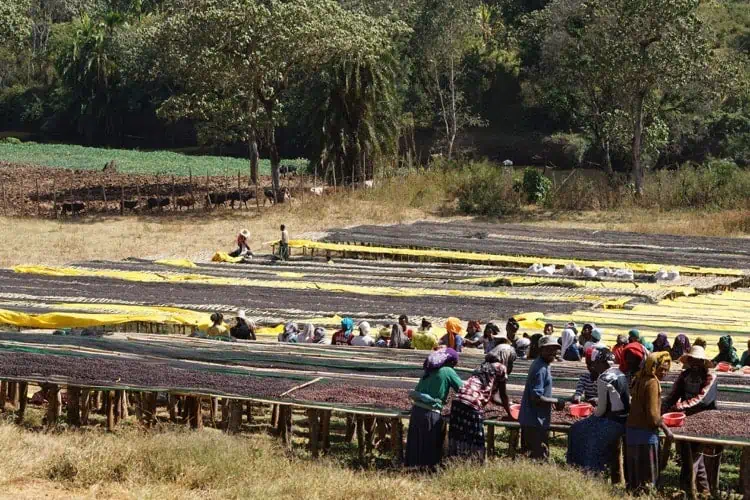
Natural processed coffee being sun-dried in Ethiopia. Courtesy of importer Pebble Coffee, Taiwan.
The champion of the cupping, at least for me (co-cupper Jason Sarley had some reservations), is the Per’la Ethiopia Durato Bombe, at 95. There has been a reaction against “fruit bomb” naturals recently among some coffee insiders, and I suppose this coffee might be similarly dissed, although it does not particularly fit the lush fruit-and-brandy stereotype evoked by the term. Exceptionally light-roasted, and skillfully so, this is less a fruit bomb than a flowers-and-cocoa bomb, with massively complex aromatics emerging from a juicy, sweet-savory structure. Paul Massard, co-founder and managing partner at Per’la, told me that the previous season this coffee had proven so popular among his customers that this year he bought enough to offer it continuously over the past seven months.
The Economics of the Everyday Yet Exceptional Bean
As one might expect in regard to larger lots of coffees aimed at satisfying a broad range of customers, the average retail price for the coffees reviewed this month is a reasonable one: US$1.59 per dry ounce, or around $19 for a 12-ounce bag. This is typical for many of the coffees we rate in the 92-94 range at Coffee Review. On the other hand, typical prices for very high-rated coffees, often microlots processed using exotic techniques and/or produced from rare tree varieties, average significantly higher. Coffees scoring 95-96 in our Top 30 for 2021 averaged a rather daunting $11.60 per ounce, while those rated 92-94 averaged $1.48 per ounce, close to figure for this month’s reviewed coffees. Moving in the other direction, contrast that price with the retail price of a full-on commodity whole-bean coffee, in this case Eight O’Clock Coffee: The Original, which cost $0.52 per ounce when purchased on Amazon a couple of months ago. Or moving up the quality chain from there, the Dunkin’ Donuts Original Blend cost $1.09 per ounce, or about the price of the least expensive of the specialty single-origins we review this month, the Cup to Cup Ethiopia Yirgacheffe Kochere.
So, are the everyday single-origin coffees we review this month simply high-end commodity coffees sold through a relatively anonymous supply chain, and dressed up with fancy names? Based on the 10 samples we researched and reviewed this month, the answer is no. These ten coffees would seem to have passed through a system from farmer through exporter/importer to roaster to consumer that is relatively clear and traceable. We know, for example, that the highest rated Per’la Ethiopia Durato Bombe was collected from 626 farmers in Durato Bombe Kebele village in the Bensa District of the Sidama Zone, with the processing performed at the nearby Qunqna mill. This coffee was exported by Daye Bensa Coffee, the owner of the mill. But were those 626 farmers, many of whom probably also work at the mill, compensated fairly for the fresh coffee fruit they brought in to make up this splendid lot? Most likely yes, but confirmation is difficult at this distance.
In fact, exactly what might constitute a fair “farmgate” price (the price farmers should actually receive for their coffee once the many, many additional costs required to transform coffee into beans and transport the beans to the port have been deducted), is difficult, perhaps impossible to determine with any confidence. Take a look at the article in the industry newsletter Perfect Daily Grind titled Green Coffee Pricing Transparency is Critical and Complicated for a sense of how important, yet how bafflingly complex, the fair farmgate coffee pricing question is.
I would conclude with two rather irresponsible, half-supported conclusions. 1) Most likely the producers (both small-holding farmers and workers on larger farms) of the moderately priced, traceable specialty coffees reviewed here are not being brutally exploited like the producers of many anonymous commodity coffees. 2) Nevertheless, they should be paid better for their work, and we should be prepared to pay more for the familiar yet exceptional coffees they produce.
Thanks To:
All of those roaster correspondents who greatly enriched this report by sharing their ideas and experience regarding everyday coffees with me: Derek Anderson, Carrie Chang, Evelyn Chiang, Jay Gestwicki, Tony Greatorex of Red Rooster Coffee, Paul Massard, Ian Picco, Mark Shi of MK Coffee Roasters, James Spano and Ben Storest.










